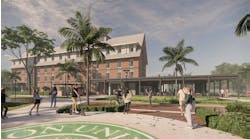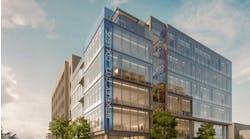Everyone loves a bargain, especially when money is tight. Swayed by a low price tag, we plunk down our cash and are pleased with ourselves for unearthing a good deal that leaves some money in our pockets.
That feeling of satisfaction can erode over time, however, as the bargain item turns out to be less than ideal. It may prove to be inadequate in accomplishing the job for which it was purchased. It may cost so much to operate that it's not worth the trouble. It may break down and continually be in the repair shop. Its functions may quickly become outdated and unnecessary.
Many schools and universities thought they were getting a good deal when they were building education facilities in the 1950s and 1960s. But the K-12 and higher-education spaces constructed to accommodate the millions of baby-boomer students no longer look like the quick-fix bargain they did years ago. Low-quality materials and construction, inefficient energy systems and uninspiring designs have left many schools and universities with facilities that are deteriorating and saddled with high maintenance and repair costs.
Today's architects and administrators have tried to learn from the errors of their predecessors and are striving to be smarter about how they plan and build education facilities. Rather than focus only on the initial construction cost of a project, designers and educators are placing greater emphasis on how much a facility will cost over its entire life. By using life-cycle costing, education institutions can have solid data to show that in some cases, spending a little more at an early stage can lead to savings over the life of a building.
“The true cost of a school is much more than the price to design and build it,” says the Collaborative for High Performance Schools' Best Practices Manual. “The long-term costs of operating and maintaining the facility must also be included. Only by evaluating all three of these parameters can a community understand how much a new school really ‘costs.’”
The hurried past
Talk to architects and educators about the school facilities that rose in the 1950s and 1960s, and they don't have much good to say about them.
“In the early 1900s, schools and courthouses were sources of pride,” says Bob McGraw, an architect and chief operating officer at Kingscott Architects in Kalamazoo, Mich. “A lot of thought went into them, and they built them to last. After World War II, they got away from that.”
One obvious reason schools got away from that is the mushrooming student enrollment experienced in the 1950s and 1960s. Enrollment in public elementary and secondary school districts soared from a little more than 25 million in 1949 to more than 45.5 million in 1969.
“Back then it was, ‘We need schools, and we need them now — we don't have time for that [life-cycle] stuff,’” says Don Carney, building management specialist with the Alaska Department of Education & Early Development.
At the same time, schools and school districts consolidated into larger entities — in 1949, the United States had more than 83,000 school districts; by 1970, there were less than 18,000. As a result, many communities lost their schools, and the connection between school and community deteriorated.
“In the last 10 to 15 years, we've gotten back to taking the longer view,” says McGraw.
The renewed focus on schools and universities as a long-term investment has manifested itself not only in the hundreds of billions of dollars spent over the past few years on education facilities, but also in how those facilities are designed, constructed, operated and maintained. Increasing numbers of architects and educators are using high-performance design strategies and environmentally friendly materials and equipment to create efficient, long-lasting facilities. Using life-cycle-cost analysis can provide the data to convince those holding the purse strings that sustainable design and construction practices are cost-effective over a building's life. The costs of using a school facility have taken on greater significance in recent years as more communities are using buildings the entire year, and on nights and weekends.
“High-performance design is gaining momentum,” says Tim Dufault, an architect with the Cuningham Group in Minneapolis.
Assessing costs
The basic premise of life-cycle costing is that the costs associated with a building do not end when the construction is complete. To accurately evaluate the entire cost of a facility, one must look at what it costs to build, operate, maintain and dispose of a facility over its lifespan.
An administrator or architect may make a philosophical argument for sustainable design because of the environmental benefits, but life-cycle costing can translate those benefits into dollars and cents. Looking at the total cost picture, an administrator can make the argument that it is more cost-effective to spend more on building a facility with materials and equipment that are durable, energy-efficient and low-maintenance.
“There's probably a 5 to 10 percent premium in construction costs for a high-performance, sustainable school,” says Dufault. “For a high school that may cost $50 million, that's a chunk of change.”
The return comes in lower energy consumption, reduced maintenance costs and a longer lasting facility. In the Summit (Colo.) district, administrators determined they needed to replace an elementary school that was showing its age after only 30 years. In 2004, the district opened the doors of Silverthorne Elementary School, which officials believe has been constructed to last as long as 100 years. According to the Rebuild Colorado program, the building cost about $145 per square foot, which is within the range of typical school construction in that area. Annual energy costs are about $36,200; a school constructed with merely a code-compliant design would have yearly energy costs of about $63,500.
Dan Huenneke, director of business for the Summit district, says Silverthorne uses optimal amounts of daylighting to reduce the need for electric light, low-maintenance paint and other materials, and higher insulation levels to endure the mountain climate.
Having a facility that will last is especially important in areas with harsh climates that can cause a building to wear down prematurely.
“We really are trying to make a push toward life-cycle-cost analysis in new construction,” says Carney. “In Alaska, the elements are hard on a building. If that isn't taken into consideration when you build the building, then the facility is not going to last.”
Sustaining progress
The most effective way to evaluate life-cycle costs is to assess the alternatives early in the design process.
“You have to allow enough time to do advanced planning,” says Huenneke. “We took the time to research a lot of the new potential solutions. Some school districts have been put into a position where they didn't have enough time.”
By the time spending decisions have been made, a school or university might not be able to integrate sustainable features into a project.
“It's a commitment that schools have to make early enough to develop the budget to support it,” says Dufault. “It's hard to come back after a bond has passed and a budget is in place and try to do all these things.”
The biggest barrier to embracing life-cycle costing for many administrators and designers is the difficulty of persuading legislators, board members and taxpayers that a bigger bill upfront is justifiable because of the savings that a more efficient project will generate over its lifetime.
“It's really a hard thing to get going,” says Carney. “It's hard to motivate a district that has a limited amount of funding. Doing a life-cycle cost analysis may add 40, 50 or 60 thousand dollars to the cost. Carrying out the recommendation from the analysis could add an even more considerable sum.”
Another obstacle that education officials may have to overcome is the bureaucracy that often pits capital costs against operating costs instead of viewing each as pieces of the same puzzle.
“It's hard for institutions to mix their budgets,” says Anthony Bernheim, an architect specializing in green design for SMWM in San Francisco.
Planning and education at an early stage can help institutions avoid this conflict.
“The key is to develop the capital budget to include these things from the get-go, and the savings will flow to the operating budget,” say Huenneke. “You can't do planning in isolation. You have to look at both sides — operating and capital costs.”
Many architectural firms have been promoting sustainable design, and as energy costs climb and processes such as LEED certification become more familiar, schools have recognized the benefits.
“Architects are advocating it, but in the last five or six years, we're seeing schools pushing it,” says McGraw. “We still have a long way to go.”
Sustainable approaches that can be shown to improve the learning environment, as well as save money — increased daylighting and improved indoor air quality, for example — are more likely to win over unconvinced administrators and board members, McGraw adds.
Many schools and universities may shy away from newer approaches because they are averse to risk. Carney concedes that attitude has slowed the embrace of sustainable design and life-cycle costing in Alaska.
“We want the tried, true and tested,” says Carney. “When it's 40 below and the wind is 40 miles an hour, you want to be able to rely on things.”
Although not satisfied with the pace at which schools have adopted high-performance design and life-cycle-costing approaches, advocates such as Bernheim believe that schools and universities will take note of successful projects and become believers.
“We're in a period of change,” he says. “There is much more attention on the life-cycle costs of building. Clients are at least talking about it. The more projects they do, the more comfortable they are with the approach. After they do five or six buildings, the institutions get it.”
Kennedy is staff writer for AS&U.
Long-term choices
To help education institutions work through the various options for facilities, materials and equipment in a building project, the Alaska Department of Education & Early Development has put together a Life Cycle Cost Analysis Handbook.
“Instead of merely looking at the facility in terms of cost to design and build, owners can broaden their perspective to include operations, repair, replacement and disposal costs,” the handbook states. “…The usefulness of a [life cycle cost analysis] lies not in the determination of a total cost of a project alternative, but in the ability to compare the cost of project alternatives and to determine which alternatives provides the best value per dollar spent.”
The handbook lists categories that should be included as initial costs, operations, maintenance and repair costs, replacement costs and residual value.
Initial costs include construction management, land acquisition, site investigation, design services, construction, equipment, technology and administration. Operating costs include fuel, electricity, water and sewer, garbage disposal, custodial, grounds, leases and insurance. Maintenance, repair and replacement costs include foundations, exterior walls and doors, windows, interior doors, walls and partitions, plumbing, fire protection systems, HVAC systems, electrical systems, equipment and furnishings. Residual value is the net worth of a building at the end of its projected life cycle.
“A building design that minimizes future operations and maintenance expenses leaves more money in the school district's operating budget, thus making more funds available for the education of the students,” the handbook says.

